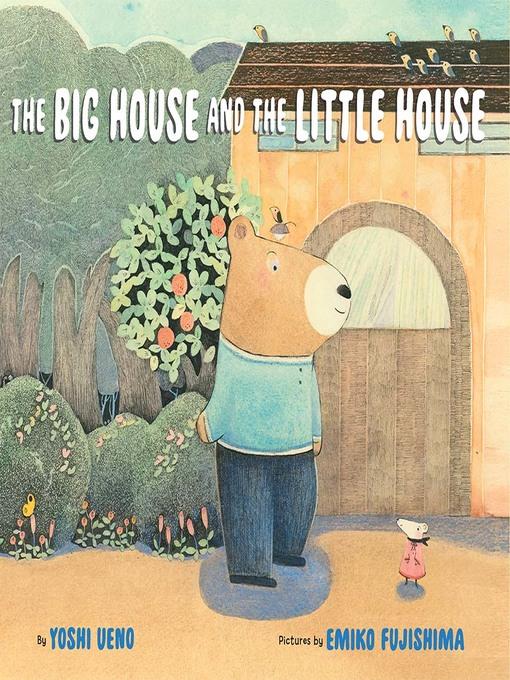
The Big House and the Little House
کتاب های مرتبط
- اطلاعات
- نقد و بررسی
- دیدگاه کاربران
نقد و بررسی

January 11, 2021
This quiet tale about two lonely animals is warmed by closely hatched spreads in gentle tints. Though they each live alone along the same road, Little Mouse goes one way, into town, each morning as Big Bear heads the other way, to the forest—“And that’s why the two of them had never met,” Ueno explains. They walk right past each other as they search for fun: “I’m the only one who is all alone,” Little Mouse says to herself as she watches families picnic in the forest; Big Bear thinks the same in a parallel spread that envisages the town. At last they meet and drink tea in Big Bear’s warm, cozy kitchen, with Little Mouse seated on an overturned teacup. The next week, in a heavy rain, Big Bear saves Little Mouse’s home while she’s still inside it, carrying it to a place that will make their friendship bloom. Lifting his friend’s house makes Big Bear a modest hero, but the drama doesn’t take over the story. Ueno’s leisurely pace and Fujishima’s comforting artwork create a bubble that surrounds and encloses readers, who come to feel part of Little Mouse and Big Bear’s world. Ages 4–7.

January 1, 2021
PreS-In a big house and a little house situated on opposite ends of a long road live a big bear and a little mouse. Each lives and works alone, never crossing paths because Little Mouse always walks to town and Big Bear always walks to the forest. Deciding to walk opposite ways one Sunday, the two pass each other "but both looked straight ahead and they didn't even notice each other!" Seeing other animals socializing in forest and town, Little Mouse and Big Bear separately feel lonely. On the way home, the two bump into each other and an invitation to tea by the bear results in a budding friendship and plans for a future meeting. When a terrible storm threatens to wash away Little Mouse's house, Big Bear comes to the rescue by saving the mouse and her small house, subsequently situated next to his own. "And neither was lonely any more." The illustrations feature muted colors and black line shading reminiscent of David McPhail's work. The round lines of the characters and the landscape create a very cozy environment. But short symmetrical sentences make the text feel almost perfunctory, and abrupt transitions do nothing to elevate a predictable story line. VERDICT What are the lessons? Big animals save small ones? Men save women? This is a sweet story, but collections may already have explored bear-mouse friendships with Karma Wilson and Bonny Becker's books.-Ramarie Beaver, formerly at Plano P.L., TX
Copyright 2021 School Library Journal, LLC Used with permission.

February 15, 2021
From far away down a long road, two animals make friends. The horizontal orientation of this title offers long left-to-right spreads, and across them wanders a pale yellow road, sloping gradually upward. "At one end was a little house, standing all alone," so tiny that readers must peer closely to glimpse the red-roofed miniature. Far away, up the low-grade hill, stands a "big house"-- big only when compared to the small one, still small in the countryside landscape. Little Mouse and Big Bear each live contentedly, but both are lonely. Details twinkle: Little Mouse works in a busy bakery (with a chef's toque and rolling pin) while Big Bear works "alone in the forest"; each heads away from the other's house to reach work; and Little Mouse explores the forest only on the single day Big Bear explores the town. The prose in this translation from the Japanese is plainspoken and elegant. Fujishima uses fine black pen for outlines, shadings, and textures while light hues--tans, pinks, blues, and greens, all pale--round out the gentle scenes. After the two bond but before they quite solidify a friendship, the river overflows, endangering Little Mouse's house. Big Bear ventures bravely out into an almost-unrecognizable panorama of rolling blue water, blue trees, and blue wind--but readers will recognize the shape of the road between the houses, and there is, natch, a happy ending that's the opposite of treacly. Tender and companionable. (Picture book. 2-7)
COPYRIGHT(2021) Kirkus Reviews, ALL RIGHTS RESERVED.

January 1, 2021
Preschool-Grade 1 Bear lives in a big house beside an oak tree. Down the road, in a little house by the river, lives Mouse. Each is lonely, but they have never met. One Sunday, Bear sees Mouse and invites her for tea. They have a wonderful conversation, discussing the town, the forest, and even their wishes. A fierce storm rages on the following Sunday, when they had planned to meet again. Realizing that the river might sweep away Mouse's home, Bear rushes to the little house, picks it up, and carries it up the road. He places it carefully beneath the oak tree. Now Mouse and Bear are good friends and neighbors. "And neither was lonely anymore." First published in Japan, this gentle picture book offers a universal theme, conveyed in a simply worded, appealing story that reads aloud well. The illustrations, expressive ink drawings enhanced with watercolor washes and colored-pencil details, suit the text well. A quiet, satisfying picture book in which two characters deal with loneliness before creating their own shared happy ending.
COPYRIGHT(2021) Booklist, ALL RIGHTS RESERVED.

























دیدگاه کاربران